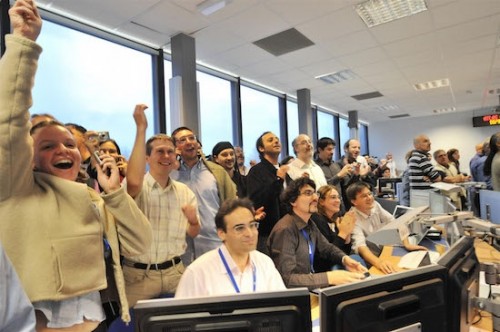
Smiley happy people: who would not want to be a particle physicist? (Courtesy: ATLAS)
By Hamish Johnston
Over on the Quantum Diaries blog, Aidan Randle-Conde has put together a lovely photo-essay called “30 reasons why you shouldn’t be a particle physicist”. It is reverse psychology, of course, and the 30 images highlight the benefits of devoting your life to studying sub-atomic particles. As someone who chose to do condensed-matter physics, do I now think that I made a huge mistake? No, but I have shared the thrill and excitement of being at CERN when the Higg’s was discovered and seen the Large Hadron Collider and its detectors up close, so I know where he is coming from.
Sometimes too much excitement can be a bad thing in physics. A case in point was the premature announcement in March last year by the BICEP2 collaboration that it had discovered the first direct evidence of cosmic inflation. It turns out that the researchers had not and what they were really seeing is the effect of dust in the Milky Way. In an interview on Sean Carroll’s Preposterous Universe blog, Caltech’s Jamie Bock explains why he and his BICEP2 colleagues made the fateful decision to release their results last year. Does Bock regret the decision? You’ll have to read the interview to find out.
We all know about the physicists Marie Curie and Maria Goeppert-Mayer but what about Cecilia Payne-Gaposchkin and Sophie Germain? They are just four of the “Pioneering women of physics” that are being featured in an infographic from the Perimeter Institute for Theoretical Physics. Released just in time for International Women’s Day on Sunday, the infographic also tells the story of how Hedy Lamarr (whose day job was being a Hollywood star) invented a frequency-hopping radio technique that is the precursor of the technology that underpins modern mobile-phone networks.
I think anybody contemplating going into particle physics should do some serious reading. There’s an increasing number of critical books out there. The latest is Science or Fiction? The Phony Side of Particle Physics by Ofer Comay.
It is quite easy to criticise than doing the things oneself. In the case of the BICEP-2 project, the team spent more than two years in the hostile polar region and did the best possible experiment and analysed in the most rigorous way taking into account the different types of known and ‘estimated’ corrections for the different types of “backgrounds” to the data. However, the contribution to the F-mode polariastion from the cosmic dust turned out to be too small as shown by the later results from the Planck work. There is nothing unworthy here as this happens quite often in research. And, of course, the comsmic inflation remains the problem in cosmology!
It was interesting to watch how the Bicep2 observations shifted from being the celebrated TV news headline grabbing ultimate proof of inflation theory to a more quiet and firmer Planck realisation that the polarisation had an entirely different dusty explanation. Seeing inflation theory as being phony and aphysical, I’d say its time to consider whether the other observations that supposedly support Inflation theory aren’t also being misappropriated and can/should be better explained by other theories based on physics rather than invention (and that would also explain the accelerating expansion of the cosmos that inflation theory fails to do).
Even if the hoped for pattern of polarization is found it still would not prove that inflation is the best theory to explain as there are other very reasonable (and more explanatory) scenarios within a big bang theory.
Trackback: Physics Viewpoint | Pioneering women of physics, why you should become a particle physicist and a BICEP2 scientist on all that dust
The Bicep team has done a very lousy service to science by running to the press and Nobel prize instead of awaiting the first referee report. Their stupidity is well received by the climate skeptics. They have proven that a scientific opinion is just an opinion. A couple of people should step down there if they want to keep some credibility.
They made a mistake but in so doing proved that the sense of proof and certainty can be very illusory, even to scientists. That is a good and appropriate thing. The uncertainty principle doesn’t just belong to quantum physics. It belongs to the cosmos and everything.
The BICEP-2 team did their best to treat their signal with respect to the different contributions to the background, but that came out to be insufficient in the light of the Planck data, however, they did not make any mistake as such. Moreover, here, one is not talking about the statistical or systematic uncertainty of the data themselves.
Students, teachers and research-workers in Nuclear Physics and Particle Physics have to be encouraged and supported by the society in all possible ways so as to get good results. Particle Physics people should not be laughed at or jeered. Nuclear Physics and Particle Physics is very interesting and useful area of Physics.